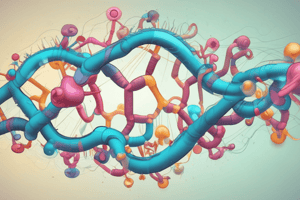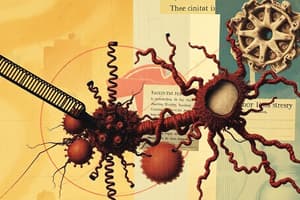Podcast
Questions and Answers
What is the primary role of eukaryotic rRNA and tRNA processing?
What is the primary role of eukaryotic rRNA and tRNA processing?
- To transport RNA from the nucleus to the cytoplasm.
- To add extra nucleotides to the 5' and 3' ends of RNA.
- To initiate RNA transcription.
- To ensure pieces of the originally transcribed RNA are removed before the RNA reaches its mature form. (correct)
In eukaryotes, ribosomal RNAs are initially transcribed by RNA polymerase II as a long 45S rRNA precursor.
In eukaryotes, ribosomal RNAs are initially transcribed by RNA polymerase II as a long 45S rRNA precursor.
False (B)
What are the non-transcribed spacers that separate the DNA encoding the rRNA genes in eukaryotes called?
What are the non-transcribed spacers that separate the DNA encoding the rRNA genes in eukaryotes called?
NTSs
In a pulse-chase experiment, rRNA is briefly labeled with radioactivity during the ______ phase.
In a pulse-chase experiment, rRNA is briefly labeled with radioactivity during the ______ phase.
Which enzyme is known to be very important in the cleavage of the precursor into mature forms of bacterial rRNA?
Which enzyme is known to be very important in the cleavage of the precursor into mature forms of bacterial rRNA?
In bacterial rRNA processing, sequences flanking the 23S rRNA gene create an extended hairpin, and the cleavage sites on either side of the hairpin are offset by 5 nucleotides.
In bacterial rRNA processing, sequences flanking the 23S rRNA gene create an extended hairpin, and the cleavage sites on either side of the hairpin are offset by 5 nucleotides.
What enzyme first cleaves bacterial tRNA precursors into individual tRNA molecules?
What enzyme first cleaves bacterial tRNA precursors into individual tRNA molecules?
The first step in tRNA processing involves removing the extra RNA at the 5' end of the pre-tRNA, called the ______.
The first step in tRNA processing involves removing the extra RNA at the 5' end of the pre-tRNA, called the ______.
What is the catalytic component of E. coli RNase P?
What is the catalytic component of E. coli RNase P?
Capping in pre-mRNA involves adding a string of AMPs to the 3' end.
Capping in pre-mRNA involves adding a string of AMPs to the 3' end.
Briefly describe the two main modifications to pre-mRNA apart from splicing.
Briefly describe the two main modifications to pre-mRNA apart from splicing.
During mRNA capping, the m7G is linked by three ______ to the next nucleotide.
During mRNA capping, the m7G is linked by three ______ to the next nucleotide.
During mRNA capping, which phosphate from GTP is retained in the cap?
During mRNA capping, which phosphate from GTP is retained in the cap?
Capping occurs after the chain length of mRNA reaches 100nt.
Capping occurs after the chain length of mRNA reaches 100nt.
Name three functions of mRNA caps.
Name three functions of mRNA caps.
According to the data presented, the cap confers a ______-fold stimulation of translation on mRNA with a PolyA tail.
According to the data presented, the cap confers a ______-fold stimulation of translation on mRNA with a PolyA tail.
Match the following rRNA processing steps with their precursor sizes:
Match the following rRNA processing steps with their precursor sizes:
Which of the following is NOT a function of mRNA caps?
Which of the following is NOT a function of mRNA caps?
U6 snRNA is transcribed by Pol II and gets m7G caps, similar to U1 snRNA.
U6 snRNA is transcribed by Pol II and gets m7G caps, similar to U1 snRNA.
What is the significance of adding a cap to mRNA transcripts for their function and transport?
What is the significance of adding a cap to mRNA transcripts for their function and transport?
Flashcards
rRNA & tRNA Processing
rRNA & tRNA Processing
rRNAs and tRNAs must be processed; the originally transcribed RNA has pieces removed before reaching its mature form.
Pulse-chase experiment
Pulse-chase experiment
Labeling a molecule briefly with radioactivity, then using non-radioactive material to track the radioactivity's fate over time.
rRNA/tRNA extra RNA
rRNA/tRNA extra RNA
These RNAs contain extra RNA at the 5' and 3' ends that must be removed.
RNase P
RNase P
Signup and view all the flashcards
mRNA Capping
mRNA Capping
Signup and view all the flashcards
mRNA cap functions
mRNA cap functions
Signup and view all the flashcards
Polyadenylation
Polyadenylation
Signup and view all the flashcards
Nucleolus
Nucleolus
Signup and view all the flashcards
Ribosomal RNA Processing
Ribosomal RNA Processing
Signup and view all the flashcards
pre-tRNAs
pre-tRNAs
Signup and view all the flashcards
RNAse III
RNAse III
Signup and view all the flashcards
Leader Removal
Leader Removal
Signup and view all the flashcards
mRNA capping: Location
mRNA capping: Location
Signup and view all the flashcards
tRNA enzyme processing
tRNA enzyme processing
Signup and view all the flashcards
RNAse III
RNAse III
Signup and view all the flashcards
5' and 3'ends
5' and 3'ends
Signup and view all the flashcards
Study Notes
rRNA & tRNA Processing
- Eukaryotic and bacterial rRNA genes are transcribed into larger precursors which must be processed into mature rRNAs.
- Several different rRNA molecules are embedded in a precursor, and each must be cut out.
- In eukaryotes, DNA encoding rRNA genes are clustered together and separated by non-transcribed spacers (NTSs).
- Ribosomal RNAs are the most highly transcribed RNAs in the cell. The gap between rRNA genes and NTSs are clearly visible by electron microscopy.
- rRNA genes are concentrated in the nucleolus, a distinct, electron-dense region of ribosome assembly in the nucleus.
- Ribosomal RNAs are transcribed as a precursor and processed into individual components.
- Eukaryotic ribosomal RNAs that will eventually make up the ribosome are initially transcribed by pol I as a long 45S rRNA precursor; the exact length varies by species.
- First, the 5’ spacer is removed, then the 41S precursor is cleaved into the 20S and 32S precursors.
- The 32S is cut into the mature 5.8S and 28S rRNAs, and the 20S is trimmed into the 18S
- The 5.8S and 28S rRNAs base pair in the mature ribosome.
- In a pulse-chase experiment rRNA is briefly labeled with radioactivity, then the radioactivity is chased using non-radioactive uridine or ATP. The fate of the radioactivity is then tracked.
- Radioactivity initially incorporated into the 45S rRNA gradually becomes the 28S and 18S rRNA over time.
- The order and specificity of rRNA processing is orchestrated by small nucleolar ribonucleoproteins (snoRNPs), which contain small nucleolar RNAs (snoRNAs)
- Bacterial rRNA is transcribed as a long precursor; one enzyme is important in cleavage of the precursor into mature forms is RNAse III.
- Sequences flanking the 23S rRNA gene create an extended hairpin, which is the recognition site for this enzyme. The cleavage sites on either side of the hairpin are offset by 2 nucleotides.
- Transfer RNAs are made in all cells as overly-long precursors (pre-tRNAs which must be processed by removing RNA at both ends.
- Bacterial precursors might contain one or more tRNA (like a tRNA “operon”). RNase III cleaves this into individual tRNA precursors.
- The first step in tRNA processing is removal of the extra RNA at the 5’ end of the pre-tRNA, called the leader, and is performed by RNAse P, which yields the mature 5’ end of the pre-tRNA.
- The RNAse P enzyme has two components, one protein and one RNA.
- The RNA component is the catalytic component of RNAse P.
Capping and Polyadenylation
- Capping is the process of adding a blocking nucleotide, m7Gppp, to the 5’ end of pre-mRNA.
- Polyadenylation is the process of adding a string of AMPs to the 3’ end
- The m7G is linked by three phosphates to the next nucleotide. The α phosphate, but not β or γ, of GTP is retained in the cap. The α and β phosphates of ATP initiated RNA synthesis and are retained in the cap.
- In cap synthesis RNA triphosphatase removes γ phosphate, then guanylyl transferase attaches GMP from GTP.
- Methyl transferase transfers a methyl group from SAM to N7 of guanine. Another methyl transferase uses another SAM to methylate the 2’-hydroxyl of the next nucleotide
- Some viruses, like cytoplasmic polyhedrosis virus, lack SAM, and capping occurs very early, soon after the first phosphodiester bond in the pre-mRNA.
- Adenovirus replicates in the nucleus and likely simulates pre-mRNAs. Caps are added before a chain length reaches 70nt. Capping occurs on mRNAs before chain length reaches 30nt.
- The functions of caps include protecting the mRNA from degradation, enhancing translation of mRNAs, enhancing transport of mRNAs from the nucleus to the cytoplasm, and enhancing the efficiency of splicing.
- Capped mRNAs are more stable, and uncapped mRNAs suffer the most degradation.
- A Cap confers 297 fold stimulation of translation on mRNA with PolyA tail.
- U1 snRNA is transcribed by Pol II and gets m7G caps, travels to the cytoplasm, binds to proteins to form snRNPs, and the caps get trimethylated. They re-enter the nucleus as an active complex.
- U6 snRNA is transcribed by Pol III and stays uncapped, and remains in the nucleus.
- U1 made by Pol III remained in the nucleus, which is consistent with the presence of a cap being important for RNA export to the cytoplasm.
Studying That Suits You
Use AI to generate personalized quizzes and flashcards to suit your learning preferences.



